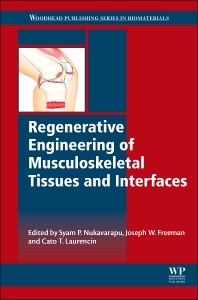Description
Regenerative Engineering of Musculoskeletal Tissues and Interfaces
Woodhead Publishing Series in Biomaterials Series
Coordinators: Nukavarapu Syam, Freeman Joseph, Laurencin Cato
Language: English
Subjects for Regenerative Engineering of Musculoskeletal Tissues and...:
Keywords
Advances and challenges; Allografts; Ankle ligament sprains; Articular cartilage; Autografts; Autologous chondrocyte implantation (ACI); Autologous chondrocyte transplantation (ACI); Bilayered scaffolds systems; Bioceramics; Biological tissue grafts; Biomaterial; Biomaterials; Bioreactor; Bone; Bone-tendon junction; Cartilage; Cartilage defects; Chondroprotective; Collagen; Controlled release; Electrospinning; Embryonic development; Embryonic stem cell (ESC); Endothelial progenitor cell (EPC); Engineered bone products; Enthesis; Exogenous electrical stimulation; Extracellular matrix (ECM); Fibrocartilage; Gel drying; Glycosaminoglycans; Growth factors; Guidance channels; Human embryonic stem cell (HESC); Hydrogels; Implant; Interface; Interface tissue engineering; Knee; Knee ligament sprains; Ligament; Ligament sprains; Menisci; Meniscus; Mesenchymal stem cells (MSCs); Mesenchymal stem/progenitor cell (MSC); Muscle; Muscoloskeletal; Musculoskeletal; Myotendinous junction; Natural; Natural extracellular matrix (ECM); Nerve injury; Neurons; Osteoarthritis; Osteochondral tissue regeneration; Osteogenesis; Perivascular stromal cells; Polycaprolactone (PCL); Polymers; Regeneration; Root attachment; Scaffold; Scaffolds; Schwann cells; Single phase scaffold systems; Skeletal muscle; Stem cells; Stem cells and scaffold; Surgical ligament replacement; Synthetic; Tendon; Tendon healing; Tendon repair; Tendon tissue engineering; Tenogenesis; Tenogenic differentiation; Tissue engineering; Tissue-engineered grafts; Vascularization; Xenografts
462 p. · 15x22.8 cm · Hardback
Description
/li>Contents
/li>Biography
/li>Comment
/li>
Repair and regeneration of musculoskeletal tissues is generating substantial interest within the biomedical community. Consequently, these are the most researched tissues from the regeneration point of view. Regenerative Engineering of Musculoskeletal Tissues and Interfaces presents information on the fundamentals, progress and recent developments related to the repair and regeneration of musculoskeletal tissues and interfaces. This comprehensive review looks at individual tissues as well as tissue interfaces. Early chapters cover various fundamentals of biomaterials and scaffolds, types of cells, growth factors, and mechanical forces, moving on to discuss tissue-engineering strategies for bone, tendon, ligament, cartilage, meniscus, and muscle, as well as progress and advances in tissue vascularization and nerve innervation of the individual tissues. Final chapters present information on musculoskeletal tissue interfaces.
Part One: Basic Elements of Musculoskeletal Tissue Engineering
1. Biomaterials and Scaffolds for musculoskeletal tissue engineering
2. Cells for musculoskeletal tissue engineering
3. Growth Factors for musculoskeletal tissue engineering
4. Mechanical Forces in musculoskeletal tissue engineering
Part Two: Individual Musculoskeletal Tissues
5. Bone tissue engineering
6. Cartilage tissue engineering
7. Ligament tissue engineering
8. Tendon tissue engineering
9. Meniscus tissue engineering
10. Muscle tissue engineering
11. Vascularization of engineered musculoskeletal tissues
12. Neural Innervation of engineered musculoskeletal tissues
Part Three: Musculoskeletal Tissue Interfaces
13. Bone-Cartilage interface
14. Bone-Tendon interface
15. Bone-Ligament interface
16. Bone-Meniscus interface
17. Muscle-Tendon interface
Joseph W. Freeman is Associate Professor in the Department of Biomedical Engineering at Rutgers University his research interests
include new biomaterial-based strategies for the regeneration of musculoskeletal tissues.
Dr. Laurencin is the Van Dusen Distinguished Endowed Professor of Orthopaedic Surgery, and Professor of Chemical, Materials, and Biomedical Engineering at the University of Connecticut. In addition, Dr. Laurencin is a University Professor at the University of Connecticut (the 7th in the institution’s history). He is the Director of both the Institute for Regenerative Engineering, and the Raymond and Beverly Sackler Center at the University of Connecticut Health Center. Dr. Laurencin serves as the Chief Executive Officer of the Connecticut Institute for Clinical and Translational Science at UCONN.
Dr. Laurencin earned his undergraduate degree in Chemical Engineering from Princeton, his medical degree, Magna Cum Laude, from Harvard Medical School, and his Ph.D. in Biochemical Engineering/B
- Comprehensive review of the repair and regeneration of musculoskeletal individual tissues and tissue interfaces
- Presents recent developments, fundamentals and progress in the field of engineering tissues
- Reviews progress and advances in tissue vascularization and innervation
These books may interest you

Musculoskeletal Tissue Engineering 222.81 €



